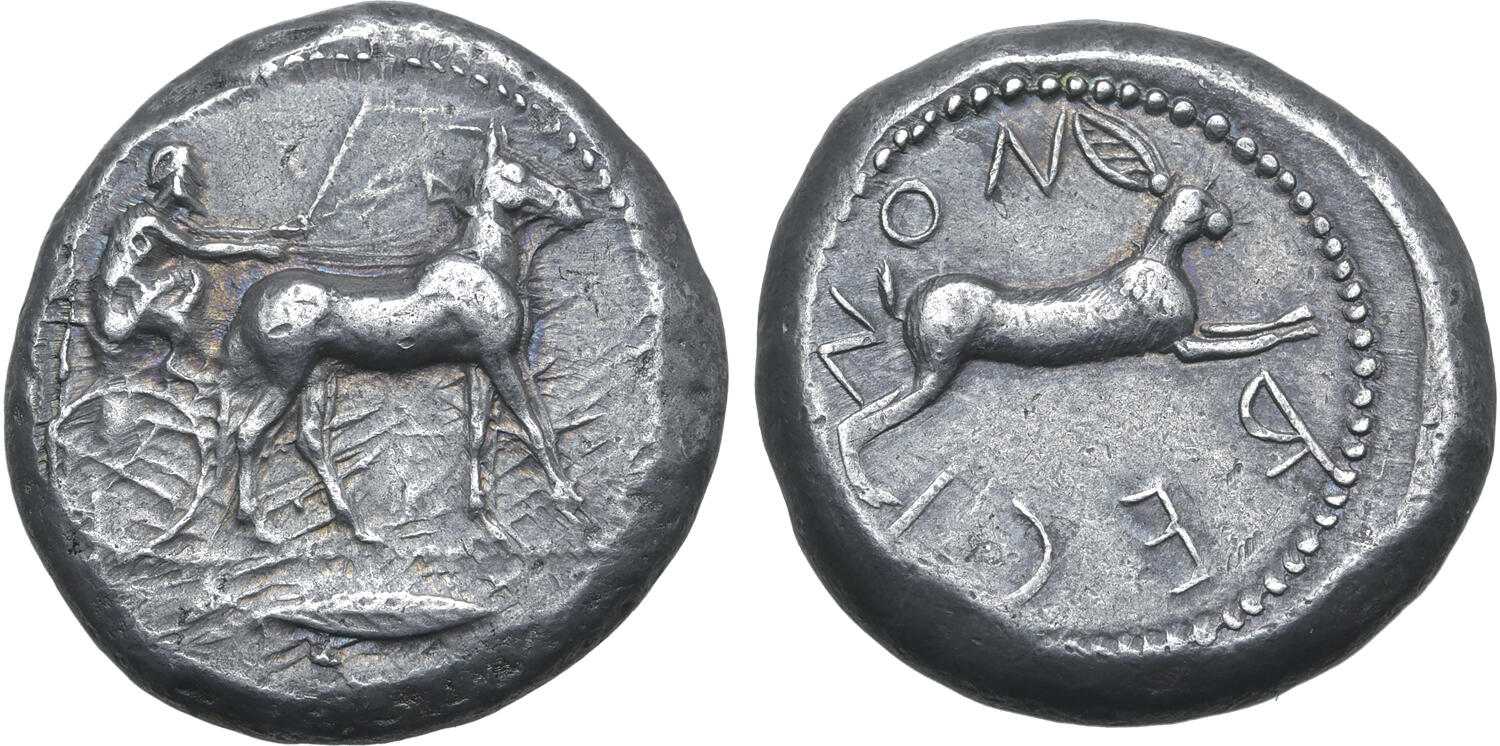Rhegium, silver, tetradrachms (mule biga/hare spinging) (480-461 BCE)
From SILVER
480 BCE - 461 BCE Silver 10,602 kg
Description
| ObverseInscription or printing placed on the obverse.: | Mule biga driven to right by seated male charioteer, laurel leaf in exergue, border dots |
| ReverseInscription or printing placed on the reverse.: | RECINON (Greek).Hare springing to right, border dots |
Mint and issuing power
| MintIdentifies the place of manufacture or issue of a numismatic object.: | Rhegium | Ancient regionAncient region.: | Modern countryModern country: Italy | AuthorityIdentifies the issuing power. The authority can be "pretended" when the name or the portrait of X is on the coin but he/she was not the issuing power. It can also be "uncertain" when there is no mention of X on the coin but he/she was the issuing power according to the historical sources: |
Chronology
| FromIdentifies the initial date in a range assigned in a numismatic context. | 480 BCE | toIdentifies the final date in a range assigned in a numismatic context.. | 461 BCE | PeriodTime period of the numismatic object.: Classical 480-323 BC |
Physical description
| MetalThe physical material (usually metal) from which an object is made.: | Silver |
Median weightMedian of the weights of numismatic objects (in grams). in grams | 17.10 | DenominationTerm indicating the value of a numismatic object. Examples: tetradrachm, chalkous, denarius.: | tetradrachm |
StandardStandard.: |
Image

AC 32 - Rhegium, silver, tetradrachm, 480-461 BC.jpg [1]
References
| Die study referencePublication of the study: | Caccamo Caltabiano 19931Caccamo Caltabiano 1993, n° 61-66 and 72-112. | ||
| Coin series referenceReference to coin series study: | Sear I2Sear I, n° 496, RQEMAC3RQEMAC, n° 32, HN Italy4HN Italy, n° 2472-2474, HGC 15HGC 1, n° 1632 | ||
| Coin series web referenceCoin series web references: | |||
Obverse dies distribution
| FrequencyFrequency of specimen in distribution. ᵖ | Number of obversesNumber of obverse dies. ᵖ (o) | % (o) | Number of coinsNumber of coins. (n) | % (n) | Die nameName(s) of the die(s). |
| 1 | 6 | 22.22 | 6 | 5.22 | 30, 36, 37, 43, 45, 52 |
| 2 | 7 | 25.93 | 14 | 12.17 | 35, 38, 47, 48, 51, 54, 57 |
| 4 | 2 | 7.41 | 8 | 6.96 | 40, 55 |
| 5 | 4 | 14.81 | 20 | 17.39 | 42, 46, 49, 53 |
| 6 | 2 | 7.41 | 12 | 10.43 | 29, 58 |
| 7 | 3 | 11.11 | 21 | 18.26 | 28, 44, 56 |
| 8 | 1 | 3.7 | 8 | 6.96 | 39 |
| 9 | 1 | 3.7 | 9 | 7.83 | 50 |
| 17 | 1 | 3.7 | 17 | 14.78 | 41 |
| Total | 27 of 27 | 99.99 | 115 of 115 | 100 |
Reverse dies distribution
no distribution is available
Quantification
| Number of obversesNumber of obverse dies. ᵖ (o) | 27 | Number of singletons (o1)The number of singleton coins. ᵖ | 6 |
| Number of reverse diesNumber of reverse dies. (r) | 35 | Number of coinsNumber of coins. (n) | 115 |
| Coins per obverse dieNumber of coins per obverse die. (n/o) | 4.26 | Coins per reverse dieNumber of coins per reverse die. (n/r) | 3.29 |
| Reverse per obverse ratioRatio of obverse dies divided by reverse dies. (r/o) | 1.3 | Percentage of singletons (o1)number of coins (n) divided by the number of singletons (o1) ᵖ | 22.22 % |
| Original number of dies (O) (Carter 1983 formula)The estimation of the number of coins according to Carter 1983 ᵖ | 31 | Coins struck if 20,000 as average productivity per dieCoins made if the average productivity for obverses (according to Carter) is 20,000. ᵖ | 620,000 |
| Original number of dies (O) (Esty 2011 formula)The estimation of the number of coins according to the singleton formula in Esty 2011 ᵖ (O) | 35.28 | Survival rate if 20,000 as average productivity per dieSurvival rate if average productivity is 20,000. ᵖ | 0.00019 |
| Coverage (o = % of O) (Esty 1984 formula)Esty 1984 - coverage (% of O) ᵖ (o = % of O) | 94.78% | Die productivity if survival rate 1/2,000Average productivity if survival rate is 1/2,000. ᵖ | 7,419.35 |
| Weight of silver (in kg) if 20,000 coins per die (O = Carter formula)Carter 1983 * Median weight * 20000 (*10 if gold or electrum) ᵖ | 10,602 kg <br /> 10,602 kg | Die productivity if survival rate 1/5,000Average productivity if survival rate is 1/5,000. ᵖ | 18,548.39 |
Remarks
Likely military
References
- ^ Caccamo Caltabiano, Maria (1993), La monetazione di Messana. Con le emissioni di Rhegion dell’eta della tirannide, AMUGS XIII, Berlin-New York, xviii, 383 p., 94 pl.
- ^ Sear, David R. (1978), Greek coins and their values. Vol. I, Europe, London, xl, 316 p.
- ^ Callataÿ, François de (2003), Recueil quantitatif des émissions monétaires archaïques et classiques, Numismatique Romaine, Wetteren, VII + 267 p.
- ^ Rutter N. Keith et alii (eds.) (2001), Historia Numorum Italy, London, xvi, 223 p., 43 pl.
- ^ Hoover, Oliver D. (2018), The Handbook of Greek Coinage Series, Volume 1. Handbook of Coins of Italy and Magna Graecia, Sixth to First Centuries BC., Lancaster-London, 2018, lxi, 527 pages, 23 cm